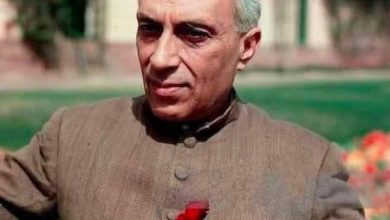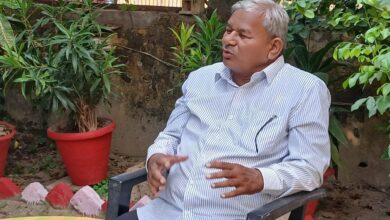The Rise of BJP : Hindutva, Political Vacuum, and Misplaced Blame on Jayaprakash Narayan
Jayaprakash Narayan: A Secular Socialist, Not a Catalyst for Hindutva
Ram Dutt Tripathi

The phenomenal rise of the Bharatiya Janata Party (BJP) from a marginal force in the 1980s to the dominant force of Indian politics has reshaped the nation’s ideological and electoral landscape. Some commentators, in retrospect, have blamed Jayaprakash Narayan (JP) for this trajectory, arguing that by including the Jana Sangh in the Janata Party coalition, he “legitimized” the Hindu right. But this claim misrepresents both JP’s legacy and the BJP’s actual path to power.
This article explores the real causes of BJP’s rise, disentangles myths about JP’s role, and examines how ideological rebranding, identity politics, leadership failures, and voter realignments created the conditions for the BJP’s ascent.
BJP’s Humble Beginnings
The BJP was established in 1980 following the collapse of the Janata Party experiment. Emerging from the Bharatiya Jana Sangh, the new party initially adopted the ideology of “Gandhian Socialism” under the leadership of Atal Bihari Vajpayee. Far from Hindutva, its early appeal was moderate and centrist.
However, the party floundered at the polls, winning only 2 seats in both the 1980 and 1984 Lok Sabha elections. It wasn’t until the late 1980s — after an ideological shift — that the BJP found electoral momentum.
Jayaprakash Narayan: A Secular Socialist, Not a Catalyst for Hindutva
Some narratives blame Jayaprakash Narayan for laying the groundwork for BJP’s rise by bringing the Jana Sangh into the anti-Emergency coalition. This is a deeply flawed reading of history.
JP was a Gandhian socialist, a staunch secularist, and one of the most respected moral voices of the Indian freedom movement. His “Total Revolution” was an appeal to democratic ethics, not communal ideology. He united opposition forces in 1977 — including socialists, Gandhians, and the Jana Sangh — to restore democracy after the Emergency, not to endorse any sectarian worldview.
The Janata Party collapsed not because of JP, but because of its internal contradictions, especially over the Jana Sangh’s continued association with the RSS. The BJP’s eventual rise came almost a decade later, after consciously abandoning centrist politics in favor of Hindutva.
To blame JP for this ideological transformation is not only historically inaccurate but also morally unjust. His legacy must be remembered as one of democratic resistance, not as a stepping stone for majoritarian politics.
3. The Ideological Pivot: Embracing Hindutva
The real shift in BJP’s fortunes came under L.K. Advani in the mid-1980s. In 1986, the BJP formally backed the Ram Janmabhoomi movement, calling for the construction of a Ram temple at Ayodhya. This move tapped into a growing sense of Hindu cultural assertiveness

• In the 1989 elections, BJP jumped from 2 to 85 seats.
• In 1990, Advani launched the Rath Yatra, igniting mass mobilization and communal polarization.
• By 1991, the BJP had secured 120 seats, firmly establishing itself as the principal opposition.
This marked the party’s full embrace of Hindutva — a shift that JP would have ideologically opposed.
4. Rajiv Gandhi’s Missteps: Losing Both Hindu and Muslim Confidence
A pivotal factor in the BJP’s rise — and Congress’s unraveling — was the contradictory political course taken by Rajiv Gandhi during his tenure (1984–1989).
• In 1985, Rajiv overturned the Supreme Court’s judgment in the Shah Bano case, succumbing to pressure from conservative Muslim clerics. This damaged Congress’s image as a secular, reform-oriented party.
• Then, in 1986, Rajiv ordered the unlocking of the gates at the disputed Babri Masjid–Ram Janmabhoomi site, allowing Hindu worship — a move that indirectly legitimized the BJP-VHP’s temple movement.
• Just before the 1989 elections, Rajiv allowed the shilanyas (foundation-laying) of the Ram Mandir — but halted construction shortly after, trying to appease both sides and pleasing neither.
These moves eroded trust among Muslims, who shifted allegiance to the Janata Dal, and Hindus, who increasingly backed the BJP. Rajiv Gandhi’s strategy of balancing communal pressures ended up alienating both constituencies.
This miscalculation was a turning point in Indian politics. It opened up space for caste- and religion-based realignments that would dominate north Indian politics for the next three decades — and marked the beginning of Congress’s long-term decline in states like Uttar Pradesh and Bihar.
5. Mandal vs. Kamandal: Identity Politics and Hindu Consolidation
The Mandal Commission’s implementation in 1990 by V.P. Singh triggered a wave of OBC mobilization and upper-caste resentment. Simultaneously, Janata Dal factions — led by Lalu Prasad Yadav, Mulayam Singh Yadav, and V.P. Singh — cemented a secular-Muslim-OBC coalition.
While this was progressive in terms of caste empowerment, it also polarized north Indian politics:
• Muslims moved toward Janata Dal and its offshoots.
• Many Hindus, especially upper castes and urban voters, felt displaced and gravitated toward the BJP.
The perceived political unity of Muslim voters behind Janata Dal inadvertently triggered a Hindu consolidation that strengthened BJP’s base.
This “Mandal vs. Kamandal” dynamic helped BJP emerge as the new voice of the Hindu middle class and consolidated a lasting vote bank in Hindi heartland states.
6. Congress’s Structural Decline
Post-1990, the Congress party struggled to recover. Under Sonia Gandhi and Rahul Gandhi, it could neither reclaim the secular legacy convincingly nor connect with the new aspirational class.
• Its message was often perceived as minority-appeasing rather than truly inclusive.
• The organizational base crumbled in key Hindi-speaking states.
• The BJP, in contrast, appeared decisive, culturally rooted, and development-oriented — especially under Narendra Modi.
By 2014, BJP was no longer just a Hindu party — it had become the dominant national party, subsuming both Congress’s nationalist space and Janata Dal’s caste legacy.
Conclusion: BJP’s Rise Was Strategic — Not JP’s Legacy
The BJP’s transformation from fringe player to ruling party was a result of strategic ideological shifts, identity politics, and the vacuum created by Congress’s errors. The rise was:
• Enabled by Hindutva mobilization (Ram Janmabhoomi),
• Fueled by Rajiv Gandhi’s contradictory communal politics,
• Accelerated by Mandal-era Hindu anxieties, and
• Cemented by the Congress’s strategic paralysis in north India.
To blame Jayaprakash Narayan — a lifelong socialist, secular democrat, and moral force — for this is not just historically inaccurate, but also intellectually lazy. JP stood against authoritarianism and injustice, and his vision was far removed from the majoritarian politics that later shaped the BJP.
His memory must be preserved not as the origin of Hindutva’s rise — but as its ideological opposite .





